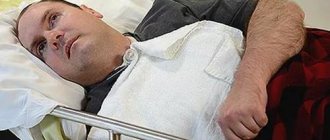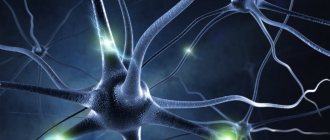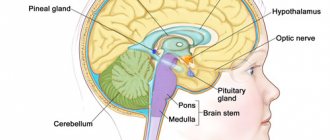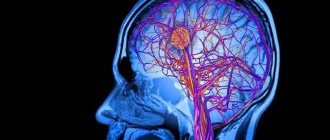A stroke that occurs to a person is a very serious phenomenon, which is a disturbance or failure in the circulatory processes of the brain. Its characteristic consequence, in the vast majority of cases, is cerebral edema during a stroke. This is one of the most dangerous manifestations, which often causes death.
If a cerebral hemorrhage is suspected, it is necessary to urgently provide the patient with medical assistance, since the development of edema occurs within a fairly short time interval after the attack. If timely measures are not taken, this can cause irreversible damage.
Causes of cerebral edema during stroke
The grounds for violations may be of different nature. Swelling of the brain after a stroke often occurs due to an increase in the amount of watery accumulations in the organic tissues connecting nerve cells. Their volume gradually increases, squeezing the brain centers. This creates excessive intracranial hypertension.
The formation of a stroke, according to doctors, is often caused by the following reasons:
- Atherosclerosis
- Hypertension
- Head injuries
- Life stresses
- Having bad habits
- Old age
- Sudden change in altitude
- High physical activity
There are other reasons - for example, vascular thrombosis. This may indicate a violation of the hematopoietic processes, as the lymphatic fluid tries to replace dead areas and protect the body.
Types of edema
There are the following types of edema caused by acute circulatory disorders in the vessels of the brain:
- local: formed in a limited area and does not spread to other areas;
- diffuse: spreads to one hemisphere of the brain;
- generalized: the pathological phenomenon extends to both hemispheres.
Depending on the location of the edema, there are:
- swelling of the brain substance;
- swelling of the organ's blood vessels;
- swelling of the brainstem.
Symptoms depend on the degree of damage and can range from swelling of the extremities to a coma in the patient.
Symptoms of the lesion
Each nature of such disorders has its own clinical context. The most indicative symptoms occur with hemorrhagic stroke. Ischemia does not develop immediately, so the increase in symptoms occurs gradually.
Headache, nausea, dizziness, and visual disturbances are noted. After a short period of time, more serious symptoms occur.
Their number and combination may vary:
- Speech disturbance and confusion
- Paralysis of arms or legs and general muscle weakness
- Facial paralysis
- Vision loss, hearing loss and spatial disorientation
- Tumors of the extremities
- Blackouts and fainting
A characteristic feature is that loss of consciousness often progresses to a coma, which in most cases ends in death. Survival prognosis is no more than 35% - 40%.
Why do limbs swell?
A stroke is a powerful blow to the left and right hemispheres of the brain, disabling not only the central nervous system, but the functioning of the entire organism as a whole.
If the cerebellum and right hemisphere, which is responsible for the physical functions of the body, are damaged, the patient experiences convulsions, swelling, numbness, sensitivity is lost, and paralysis of the limbs is possible.
This is why patients often complain that their legs are swollen.
This disease is terrible precisely because of its consequences - the functioning of the kidneys, heart, and genitourinary system is disrupted. Swelling of the legs (failure of fluid exchange) is a consequence of these disorders.
Important! Swelling of the legs appears within 1-2 hours after a stroke; emergency medical assistance is necessary to prevent a recurrence of the crisis.
Next we will tell you the specific reasons for the violation.
Heart failure
As a result of unstable heart function, limited blood supply to the legs or arms occurs. After a stroke, the heart muscle cannot cope with the volume of blood, and stagnation occurs. Reason: when the right side is affected, the blood, overflowing the veins, penetrates the tissues of the arms, legs and liver.
Varicose veins
After a stroke, the functioning of the entire circulatory system is disrupted - the vessels dilate, the walls fill with blood, become thin, as a result, the legs swell and greatly increase in size.
It is important to prevent the formation of blood clots by increasing the tone of the vessel walls and improving blood flow.
Thrombosis
After a stroke, with temporary paralysis, the patient practically does not move, and is always in a supine position. The blood stagnates and becomes thick not only in small capillaries, but also in the deep veins of the legs and arms. The cells “starve”, the limbs go numb, severe swelling occurs, accompanied by pain and bluish skin. People with varicose veins and other vascular diseases are especially at risk for thrombosis.
It is impossible to cure thrombosis on your own with massage or special exercises; urgent surgery is required (removal of a blood clot or installation of special filter devices that “catch” clots).
Kidney complications
After a stroke, the water balance is disrupted, the body can accumulate water, and dehydration is also possible. A distinctive sign is that not only the legs and arms swell, but also the face. The swelling is pale, warm, soft to the touch.
Possible necrosis and kidney failure; Inpatient treatment, special medications, and massage are required. Kidney prevention is very important.
When paralyzed
After a stroke, temporary immobilization of the right or left side is possible (sensitivity and muscle tone are impaired).
In this case, swelling of the paralyzed leg is a common occurrence.
Reasons why a paralyzed leg swells:
- Clamping of large vessels. When paralyzed, a person does not feel discomfort, cannot roll over, or change body position. And if a bedridden patient lies in one position for a long time, the vascular system is pinched, blood circulation is disrupted, and swelling appears.
- Stagnation of venous blood and lymph. The hanging position of the foot or hand is unacceptable - blood stagnates in the paralyzed limbs. The situation is aggravated by muscle weakness. As you know, muscle work ensures normal blood flow.
- Thrombosis. A distinctive feature is that the leg becomes hot, and pain occurs when lightly pressed. In this case, immediate assistance from a specialist is required.
Cerebral edema: mechanisms of development
Brain cells need a constant supply of energy, which is supplied through blood vessels. Nutrients move through them. Between the cells and vessels there is lymphatic fluid.
As these vessels become blocked by various clots, a deficiency in blood supply occurs. The nutritional mechanisms of the brain are disrupted, which leads to the accumulation of fluid and difficulties with its removal. Swelling occurs.
Visually, cerebral edema during any stroke is characterized by swelling of one or more limbs. There may be swelling in certain parts of the face, as well as sagging of the cheeks or corners of the mouth.
First aid
Emergency care for stroke is a set of techniques aimed at saving life. The chance of restoring the brain and functioning of the nervous system depends on the time and accuracy of their provision.
If there is a suspicion of a stroke, you need to act according to a specific algorithm:
- Avoid panic and excessive anxiety
- Assess the patient’s condition - pressure, signs of breathing and heartbeat
- Identify characteristic signs - impaired speech functions, paralysis and others
- Call emergency help
- If there is no heartbeat and breathing, perform resuscitation measures - cardiac massage and artificial respiration
- Place the patient on his back in a horizontal position and slightly raise his head
- Give medications to lower blood pressure
Consequences of swelling
Problems with blood circulation in the head cause negative consequences. Dying nerve cells impair vital functions. Even after medical procedures, it is difficult to resume them . After the first attack, the likelihood of another stroke increases. The condition worsens as follows:
- There is no adequate thinking.
- Unable to control senses.
- The person is poorly oriented in space, etc.
Coma and death are considered the most dangerous consequences.
Diagnostics
Diagnosis of cerebral edema during stroke should be made at the earliest possible stage. It is divided into 2 groups - pre-medical, which is performed by the patient himself or the people around him, and medical, which is performed by a specialist.
Pre-medical preliminary diagnosis comes down to identifying the characteristic, already mentioned, symptoms inherent in the condition of a stroke and taking measures for hospitalization.
In a medical institution, a specialist can make a specific diagnosis only after carrying out a set of diagnostic measures:
- Collection of information about the patient, his chronic and hereditary diseases
- Visual inspection and testing
- Laboratory methods for studying blood tests
- Hardware diagnostics using stationary equipment
The most effective hardware diagnostic methods include the following:
- CT scan;
- Magnetic resonance imaging;
- magnetic resonance angiography;
- cerebral angiography;
- Doppler ultrasound.
There are also additional methods for examining the patient, such as ECG, spinal puncture and a number of other techniques.
All these methods, taken together or in separate combinations, give the doctor a complete understanding of the nature of the edema, its type, the volume of the affected areas, the condition of the blood vessels and other parameters that allow prescribing the optimal treatment option.
Preventive and therapeutic measures
It often happens that to avoid cerebral edema during a stroke, it is enough to regularly carry out preventive measures aimed at adjusting diet and rest, especially for people who are overweight or prone to hypertension.
It is necessary to periodically monitor blood pressure, avoid drinking alcohol, nicotine and other bad habits, as well as emotional stress. Lead an active lifestyle and spend more time in the fresh air, exercise and follow a proper, balanced diet.
There are a number of medications, as well as vitamins and microelements aimed at preventing strokes, as well as traditional methods. In short, the choice is quite wide.
Treatment of cerebral edema
As for treatment, in accordance with the medical opinion and diagnosis, a course of therapy is prescribed, the purpose of which is to slow down and eliminate edema, as well as ensure the drainage of excess fluid. These goals are achieved through medication and surgery.
Treatment includes several points and is carried out in the intensive care unit or intensive care unit:
- Maintaining adequate respiratory function. For this purpose, medications are prescribed to stabilize breathing. Regular monitoring is carried out, the purpose of which is to regulate normal breathing, periodic sanitation of the respiratory tract is carried out, as well as oxygen therapy. In some cases, the patient is transferred to a ventilator.
- Restoration of microcirculation and blood circulation, to stabilize which special medications are prescribed that relieve vasospasm. The parameters of the cardiovascular system are monitored, and intravenous infusion is administered to maintain the required level of pressure in the circulatory system. Polyglucin or macrodex are used to thin the blood.
- Ensuring fluid drainage to reduce intracranial pressure. For this, mannitol is used, a drug that pumps out excess fluid from the brain. It is subsequently excreted from the body in urine. In some cases, a drainage procedure is performed through a catheter or forced decompression using craniotomy.
- Methods for eliminating hypoxia include the use of antihypoxic medications (Citicoline), which reduce hypoxia and prevent further development of swelling.
Treatment
Cerebral edema is a very dangerous complication and most often a patient in this condition is in a hospital, intensive care unit or intensive care. Treatment for this pathology is selected for each patient individually.
If the pathology develops against the background of a head injury, then the patient is monitored very carefully. At this moment the patient should be at rest. If the lesion is small, it goes away on its own.
In all other cases, drug treatment is added. All drugs are mainly administered intravenously. Initially, specialists do everything to improve the supply of oxygen to the brain and relieve swelling, influencing its cause. If swelling occurs due to an infection, then it must be eliminated.
To improve the patient's condition, the following procedures are performed:
- artificial ventilation to relieve oxygen deprivation;
- exclusion of convulsive conditions;
- anesthesia;
- restoration of full blood circulation and blood outflow;
- It is necessary to monitor temperature ;
- prescription of diuretics.
If drug therapy does not produce positive results, surgery is prescribed. Craniotomy is done in order to reduce intracranial pressure to normal values.
For this purpose, a decompression craniotomy is performed. This procedure involves removing a bone flap. After the pressure returns to normal, the swelling decreases.
Surgery is also prescribed if it is necessary to remove a tumor or blood clots. In some cases, a catheter is inserted to help remove excess cerebrospinal fluid. The method is modern, but despite this, it is quite risky.
The fact is that if even a small piece of bone or other foreign body gets in, the swelling can occur again and become more dangerous and impressive. Therefore, if surgical intervention is recommended, this means that there are simply no more effective treatments.











